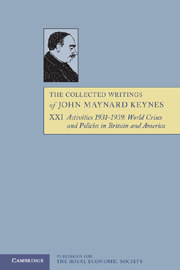Book contents
- Frontmatter
- Contents
- General introduction
- Editorial note
- 1 THE CURRENCY QUESTION
- 2 CHEAP MONEY, WISE SPENDING AND THE MEANS TO PROSPERITY
- 3 THE WORLD ECONOMIC CONFERENCE
- 4 THE NEW DEAL
- 5 THE LULL SURROUNDING THE GENERAL THEORY
- 6 SLUMP AND REARMAMENT
- 7 TOWARDS WAR
- List of Documents Reproduced
- Acknowledgements
- Index
2 - CHEAP MONEY, WISE SPENDING AND THE MEANS TO PROSPERITY
Published online by Cambridge University Press: 05 November 2012
- Frontmatter
- Contents
- General introduction
- Editorial note
- 1 THE CURRENCY QUESTION
- 2 CHEAP MONEY, WISE SPENDING AND THE MEANS TO PROSPERITY
- 3 THE WORLD ECONOMIC CONFERENCE
- 4 THE NEW DEAL
- 5 THE LULL SURROUNDING THE GENERAL THEORY
- 6 SLUMP AND REARMAMENT
- 7 TOWARDS WAR
- List of Documents Reproduced
- Acknowledgements
- Index
Summary
During the winter and spring of 1931–2 Keynes had not only been advocating the management of sterling at a relatively low level, but he had also been advocating cheap money. Such a policy was also put forward by the Prime Minister's Advisory Committee on Financial Questions in late February and early March 1932. Bank rate, which had been raised to 6 per cent when sterling left the gold standard, came down in three stages to 31/2per cent. In April, following the Budget which introduced the Exchange Equalisation Account, the rate came down to 3 per cent and on 12 May to 21/2 per cent. The stage was then set for the Chancellor's dramatic flight to London from the reparations conference at Lausanne to announce to the House of Commons on 30 June the conversion of over £2 billion of 5 per cent War Loan 1939–47 to a 31/2 Percent War Loan 1952 or after. The same day, Bank rate fell to 2 per cent, where it was to remain until August 1939.
Keynes's first comment came in a letter to C. L. Baillieu.From a letter to C. L. BAILLIEU, 7 July 1932
I consider the Conversion Scheme to be a sound stroke of policy. The Treasury are aiming at a very high percentage of conversion. I am by no means sure that they will secure this. But I should not consider it to be any reason for anxiety if, say, 25 per cent or even more were to remain unconverted, since this could be dealt with by a short-term bond issue, carrying a low rate of interest at the end of the year. For the future of the gilt-edged-market it is much more important that long-dated securities should not be in oversupply relative to the demand than that the percentage response to the present proposal should be as nearly as possible complete. The optimum arrangement from the point of view of the Treasury is to supply the different types of bonds in the proportions in which the public want them.
- Type
- Chapter
- Information
- The Collected Writings of John Maynard Keynes , pp. 112 - 202Publisher: Royal Economic SocietyPrint publication year: 1978



